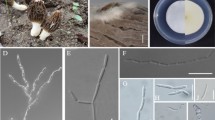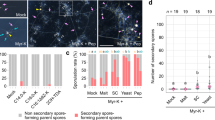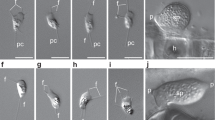Abstract
Arbuscular mycorrhizal fungi (AMF) have been symbionts of land plants for at least 450 Myr. It is known that some AMF host in their cytoplasm Gram-positive endobacteria called bacterium-like organisms (BLOs), of unknown phylogenetic origin. In this study, an extensive inventory of 28 cultured AMF, from diverse evolutionary lineages and four continents, indicated that most of the AMF species investigated possess BLOs. Analyzing the 16S ribosomal DNA (rDNA) as a phylogenetic marker revealed that BLO sequences from divergent lineages all clustered in a well-supported monophyletic clade. Unexpectedly, the cell-walled BLOs were shown to likely represent a sister clade of the Mycoplasmatales and Entomoplasmatales, within the Mollicutes, whose members are lacking cell walls and show symbiotic or parasitic lifestyles. Perhaps BLOs maintained the Gram-positive trait whereas the sister groups lost it. The intracellular location of BLOs was revealed by fluorescent in situ hybridization (FISH), and confirmed by pyrosequencing. BLO DNA could only be amplified from AMF spores and not from spore washings. As highly divergent BLO sequences were found within individual fungal spores, amplicon libraries derived from Glomus etunicatum isolates from different geographic regions were pyrosequenced; they revealed distinct sequence compositions in different isolates. Our results show a vertically inherited, monophyletic and globally distributed lineage of endobacteria thriving in AMF cytoplasm. These bacteria split from their sister groups more than 400 Myr ago, colonizing their fungal hosts already before main AMF lineages separated. The BLO–AMF symbiosis can, therefore, be dated back at least to the time when AMF formed the ancestral symbiosis with emergent land plants.
Similar content being viewed by others
Log in or create a free account to read this content
Gain free access to this article, as well as selected content from this journal and more on nature.com
or
References
Amann RI, Binder BJ, Olson RJ, Chisholm SW, Devereux R, Stahl DA . (1990). Combination of 16S rRNA-targeted oligonucleotide probes with flow cytometry for analyzing mixed microbial populations. Appl Environ Microbiol 56: 1919–1925.
Bandi C, Damiani G, Magrassi L, Grigolo A, Fani R, Sacchi L . (1994). Flavobacteria as intracellular symbionts in cockroaches. Proc Biol Sci 257: 43–48.
Battistuzzi FU, Hedges SB . (2009). A major clade of prokaryotes with ancient adaptations to life on land. Mol Biol Evol 26: 335–343.
Baumann P, Moran NA . (1997). Non-cultivable microorganisms from symbiotic associations of insects and other hosts. Antonie van Leeuwenhoek 72: 39–48.
Bennasar A, Rosselló-Mora R, Lalucat J, Moore ER . (1996). 16S rRNA gene sequence analysis relative to genomovars of Pseudomonas stutzeri and proposal of Pseudomonas balearica sp. nov. Int J Syst Bacteriol 46: 200–205.
Bertaux J, Schmid M, Hutzler P, Hartmann A, Garbaye J, Frey-Klett P . (2005). Occurrence and distribution of endobacteria in the plant-associated mycelium of the ectomycorrhizal fungus Laccaria bicolor S238N. Environ Microbiol 7: 1786–1795.
Bianciotto V, Lumini E, Bonfante P, Vandamme P . (2003). ‘Candidatus Glomeribacter gigasporarum’ gen nov, sp nov, an endosymbiont of arbuscular mycorrhizal fungi. Int J Syst Evol Microbiol 53: 121–124.
Börstler B, Raab PA, Thiéry O, Morton JB, Redecker D . (2008). Genetic diversity of the arbuscular mycorrhizal fungus Glomus intraradices as determined by mitochondrial large subunit rRNA gene sequences is considerably higher than previously expected. New Phytol 180: 452–465.
Bonfante P, Anca IA . (2009). Plants, mycorrhizal fungi, and bacteria: a network of interactions. Annu Rev Microbio 63: 363–383.
Bonfante P, Genre A . (2008). Plants and arbuscular mycorrhizal fungi: an evolutionary-developmental perspective. Trends Plant Sci 13: 492–498.
Brownlie JC, Johnson KN . (2009). Symbiont-mediated protection in insect hosts. Trends Microbiol 17: 348–354.
Cole JR, Wang Q, Cardenas E, Fish J, Chai B, Farris RJ et al. (2009). The Ribosomal Database Project: improved alignments and new tools for rRNA analysis. Nucl Acids Res 37: D141–D145.
Cranenbrouck S, Voets L, Bivort C, Renard L, Strullu DG, Declerck S . (2005). Methodologies for in vitro cultivation of arbuscular mycorrhizal fungi with root organs. In: Declerck S, Strullu D, Fortin JA (eds). In Vitro Culture of Mycorrhizas. Springer: Heidelberg, pp 341–375.
Cruz-Martinez K, Suttle KB, Brodie EL, Power ME, Andersen GL, Banfield JF . (2009). Despite strong seasonal responses, soil microbial consortia are more resilient to long-term changes in rainfall than overlying grassland. ISMEJ 3: 738–744.
Dunbar J, Barns SM, Ticknor LO, Kuske CR . (2002). Empirical and theoretical bacterial diversity in four Arizona soils. Appl Environ Microbiol 68: 3035–3045.
Elshahed MS, Youssef NH, Spain AM, Sheik C, Najar FZ, Sukharnikov LO et al. (2008). Novelty and uniqueness patterns of rare members of the soil biosphere. Appl Environ Microbiol 74: 5422–5428.
Felsenstein J . (1989). PHYLIP-phylogeny inference package (version 3.2). Cladistics 5: 164–166.
Frey-Klett P, Garbaye J, Tarkka M . (2007). The mycorrhiza helper bacteria revisited. New Phytol 176: 22–36.
Ganguly T, Chen P, Teetsel R, Zhang LP, Papaioannou E, Cianciarulo J . (2005). High-throughput sequencing of high copy number plasmids from bacterial cultures by heat lysis. BioTechniques 39: 304 306, 308.
Gomez-Alvarez V, Teal TK, Schmidt TM . (2009). Systematic artifacts in metagenomes from complex microbial communities. ISMEJ 3: 1314–1317.
Hansel CM, Fendorf S, Jardine PM, Francis CA . (2008). Changes in bacterial and archaeal community structure and functional diversity along a geochemically variable soil profile. Appl Environ Microbiol 74: 1620–1633.
Harrison MJ, Buuren MLV . (1995). A phosphate transporter from the mycorrhizal fungus Glomus versiforme. Nature 378: 626–629.
Hijri M, Sanders IR . (2005). Low gene copy number shows that arbuscular mycorrhizal fungi inherit genetically different nuclei. Nature 433: 160–163.
Hoffmeister M, Martin W . (2003). Interspecific evolution: microbial symbiosis, endosymbiosis and gene transfer. Environ Microbiol 5: 641–649.
Huelsenbeck JP, Ronquist F . (2001). MRBAYES: Bayesian inference of phylogenetic trees. Bioinformatics 17: 754–755.
Johansson K, Pettersson B . (2002). Taxonomy of mollicutes. In: Razin S, Herrmann R (eds). Molecular Biology and Pathogenicity of Mycoplasmas. Springer: Heidelberg, pp 1–30.
Kielak A, Pijl AS, Veen JAV, Kowalchuk GA . (2008). Differences in vegetation composition and plant species identity lead to only minor changes in soil-borne microbial communities in a former arable field. FEMS Microbiol Ecol 63: 372–382.
Larkin M, Blackshields G, Brown NP, Chenna R, McGettigan PA, McWilliam H et al. (2007). Clustal W and Clustal X version 2.0. Bioinformatics 23: 2947–2948.
Lee J, Young JPW . (2009). The mitochondrial genome sequence of the arbuscular mycorrhizal fungus Glomus intraradices isolate 494 and implications for the phylogenetic placement of Glomus. New Phytol 183: 200–211.
Lesaulnier C, Papamichail D, McCorkle S, Ollivier B, Skiena S, Taghavi S et al. (2008). Elevated atmospheric CO2 affects soil microbial diversity associated with trembling aspen. Environ Microbiol 10: 926–941.
Ligrone R, Carafa A, Lumini E, Bianciotto V, Bonfante P, Duckett J . (2007). Glomeromycotean associations in liverworts: a molecular, cellular, and taxonomic analysis. Am J Bot 94: 1756–1777.
Long L, Yao Q, Ai Y, Deng M, Zhu H . (2009). Detection of a novel bacterium associated with spores of the arbuscular mycorrhizal fungus Gigaspora margarita. Can J Microbiol 55: 771–775.
Ludwig W, Schleifer K, Whitman WB . (2008). Revised road map to the phylum Firmicutes. In: De Vos P, Garrity GM, Jones D, Rainey FA, Schleifer KH, Whitman WB (eds). Bergey's Manual of Systematic Bacteriology. Springer: Heidelberg.
Ludwig W, Strunk O, Westram R, Richter L, Meier H, Yadhukumar AB et al. (2004). ARB: a software environment for sequence data. Nucleic Acids Res 32: 1363–1371.
Lumini E, Bianciotto V, Jargeat P, Novero M, Salvioli A, Faccio A et al. (2007). Presymbiotic growth and sporal morphology are affected in the arbuscular mycorrhizal fungus Gigaspora margarita cured of its endobacteria. Cell Microbiol 9: 1716–1729.
MacDonald RM, Chandler M, Mosse B . (1982). The occurrence of bacterium-like organelles in vesicular-arbuscular mycorrhizal fungi. New Phytol 90: 659–663.
Maniloff J . (2002). Phylogeny and evolution. In: Razin S, Herrmann R (eds). Molecular Biology and Pathogenicity of Mycoplasmas. Springer: Heidelberg, pp 31–44.
Marchesi JR, Sato T, Weightman AJ, Martin TA, Fry JC, Hiom SJ et al. (1998). Design and evaluation of useful bacterium-specific PCR primers that amplify genes coding for bacterial 16S rRNA. Appl Environ Microbiol 64: 2333.
Margulies M, Egholm M, Altman WE, Attiya S, Bader JS, Bemben LA et al. (2005). Genome sequencing in microfabricated high-density picolitre reactors. Nature 437: 376–380.
Martin F, Gianinazzi-Pearson V, Hijri M, Lammers P, Requena N, Sanders IR et al. (2008). The long hard road to a completed ‘Glomus intraradices’ genome. New Phytol 180: 747–750.
Moran NA, McCutcheon JP, Nakabachi A . (2008). Genomics and evolution of heritable bacterial symbionts. Annu Rev Genet 42: 165–190.
Moran NA, Russell JA, Koga R, Fukatsu T . (2005). Evolutionary relationships of three new species of Enterobacteriaceae living as symbionts of aphids and other insects. Appl Environ Microbiol 71: 3302–3310.
Partida-Martinez LP, Hertweck C . (2005). Pathogenic fungus harbours endosymbiotic bacteria for toxin production. Nature 437: 884–888.
Pruesse E, Quast C, Knittel K, Fuchs BM, Ludwig W, Peplies J et al. (2007). SILVA: a comprehensive online resource for quality checked and aligned ribosomal RNA sequence data compatible with ARB. Nucleic Acids Res 35: 7188–7196.
Redecker D, Kodner R, Graham LE . (2000). Glomalean fungi from the Ordovician. Science 289: 1920–1921.
Roesch LFW, Fulthorpe RR, Riva AR, Casella G, Hadwin AKM, Kent AD et al. (2007). Pyrosequencing enumerates and contrasts soil microbial diversity. ISMEJ 1: 283–290.
Scannerini S, Bonfante P . (1991). Bacteria and bacteria-like objects in endomycorrhizal fungi. In: Margulis L, Fester R (eds). Symbiosis as a Source of Evolutionary Innovation: Speciation and Morphogenesis. MIT Press: Cambridge, MA, pp 273–287.
Schüßler A, Mollenhauer D, Schnepf E, Kluge M . (1994). Geosiphon pyriformis an endosymbiotic association of fungus and cyanobacteria: the spore structure resembles that of arbuscular mycorrhizal (AM) fungi. Botanica Acta 107: 36–45.
Schüßler A, Schwarzott D, Walker C . (2001). A new fungal phylum, the Glomeromycota: phylogeny and evolution. Mycol Res 105: 1413–1421.
Schwarzott D, Schüßler A . (2001). A simple and reliable method for SSU rRNA gene DNA extraction, amplification, and cloning from single AM fungal spores. Mycorrhiza 10: 203–207.
Schwarzott D, Walker C, Schüßler A . (2001). Glomus, the largest genus of the arbuscular mycorrhizal fungi (Glomales), is nonmonophyletic. Mol Phylogenet Evol 21: 190–197.
Sogin ML, Morrison HG, Huber JA, Welch DM, Huse SM, Neal PR et al. (2006). Microbial diversity in the deep sea and the underexplored ‘rare biosphere’. Proc Natl Acad Sci USA 103: 12115–12120.
Stamatakis A, Hoover P, Rougemont J . (2008). A rapid bootstrap algorithm for the RAxML web servers. Syst Biol 57: 758–771.
Stockinger H, Walker C, Schüßler A . (2009). Glomus intraradices DAOM197198 a model fungus in arbuscular mycorrhiza research, is not Glomus intraradices. New Phytol 183: 1176–1187.
Stockinger H, Krüger M, Schüßler A . (2010) DNA barcoding of arbuscular mycorrhizal fungi. New Phytol, in press.
Taylor TN, Remy W, Hass H, Kerp H . (1995). Fossil arbuscular mycorrhizae from the early Devonian. Mycologia 87: 560–573.
Timmis JN, Ayliffe MA, Huang CY, Martin W . (2004). Endosymbiotic gene transfer: organelle genomes forge eukaryotic chromosomes. Nat Rev Genet 5: 123–135.
Yarza P, Richter M, Peplies J, Euzeby J, Amann R, Schleifer KH et al. (2008). The All-Species Living Tree project: a 16S rRNA-based phylogenetic tree of all sequenced type strains. Syst Appl Microbiol 31: 241–250.
Acknowledgements
We thank T Pawlowska (USA), C Walker (GB), the Genebank at NIAS (Japan), S Cranenbrouck and S Declerck from GINCO (Belgium), as well as all original collectors for providing AMF cultures. We thank V Bianciotto and E Lumini for useful comments and A Faccio for TEM preparation. The research leading to these results received funding from the European Community's Sixth Framework Programme (FP6/2005–2009) under grant agreement no. MEST-CT-2005-021016 (TRACEAM), from Compagnia di San Paolo, Torino and from Converging technology Project (BIOBIT, CIPE) to PB.
Author information
Authors and Affiliations
Corresponding author
Additional information
Supplementary Information accompanies the paper on The ISME Journal website
Supplementary information
Rights and permissions
About this article
Cite this article
Naumann, M., Schüßler, A. & Bonfante, P. The obligate endobacteria of arbuscular mycorrhizal fungi are ancient heritable components related to the Mollicutes. ISME J 4, 862–871 (2010). https://doi.org/10.1038/ismej.2010.21
Received:
Revised:
Accepted:
Published:
Issue date:
DOI: https://doi.org/10.1038/ismej.2010.21
Keywords
This article is cited by
-
Characterization of microbial communities during Grifola frondosa (maitake) wood log cultivation
Journal of Wood Science (2023)
-
Coniochaeta fungus benefits from its intracellular bacteria to form biofilm and defend against other fungi
Archives of Microbiology (2021)
-
Morphological diversity of fungal reproductive units in the Lower Devonian Rhynie and Windyfield cherts, Scotland: a new species of the genus Windipila
PalZ (2020)
-
Microbial interactions within the plant holobiont
Microbiome (2018)



